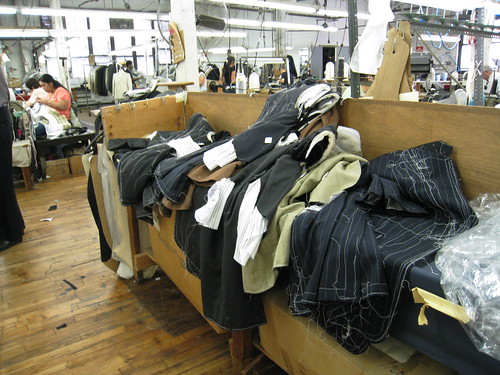
When I set off to interview Jasmin Shokrian on assignment from my men.style.com editor, I was skeptical.
Shokrian, a womenswear designer, was branching into menswear, and not with one size fits all accessories like scarves, ties, or jewelry, but with the ultimate one-size-fits-one item in a man’s wardrobe – a custom suit. She’s never made menswear in her life, I thought (as it turned out, falsely). What can she know? Sure she’s offering it through
South Willard, one of Los Angeles’ most interesting men’s stores, where it has to compete with labels like APC, Raf Simons and Veronique Branquinho, but it still sounded like a very fashionable flash in the pan.
I met Shokrian in gleaming white floor-though apartment on Prince Street that she rents for showings during Fashion Week. Actually, first I met the suit, a slim notch lapel one button model in midnight blue featherweight woven cashmere. It was nowhere near my size, but I tried it on anyway. The canvas chest piece was beautifully light. It was the first suit she has made for her first and so far only client, painter Christopher Vasell (pictured).
When Shokrian appeared we talked about it. The evolution toward menswear seems easy for her. From art school, she moved first into fabric sculptures and then into simple, sculptural womenswear in menswear fabrics. Naturally men were asking her to make things for them, in particular shawls. She showed me pictures of them that looked good. Shawls are hard for men to get away with, but if you’re like JoJo at Atelier, you can, and the effect is smashing.
Shokrian recognizes that without a men’s tailoring background, it would be hard for her to make a good suit herself, so instead she found an LA based custom tailor that she named but kept off the record, since what she’s selling is her eye and stylistic intelligence, rather than his skill with a needle. The details that were distinctively hers were a cotton backed silk lining and silk-cotton voile pocketing, both of which felt very luxurious even if, in the latter case, a bit delicate. The suit itself was unlike the tailor’s usual efforts, she said. I don’t know the tailor, so all I could see was clean modernity – no dandyism here. The coat was not fashionably short – hooray! The lapel was slightly rounded with a downward sloping notch, a signature nowadays of
Oxxford, which makes the best-tailored suit in the country but with mostly boxy, stodgy silhouettes. Hers is not. The pants are, or rather the client is, so slim that the thighs gather in with tiny pin tuck pleats on the otherwise flat front. They tapered neatly, with no cuff.
The model showing it also worked as a fit model for Marc Jacobs, in other words, skinny. Vassell had a fit model physique. I noted that one tailor’s New York Times ad showed
his men measuring NBA players and sumo wrestlers. She didn’t think they would come up in her client list. Shokrian said her clients are more likely to have fit-model physiques because of their limited size range – problem solved!
The cost is $3-4,000, depending on the fabric, which for a USA made true custom suit with several fittings is not exorbitant, so I wish her luck.
The novelty here is a contemporary multibrand men’s store offering contemporary custom. In New York downtown, one can get custom or at least Made to Measure clothing at several single-brand stores like
Duncan Quinn,
Seize sur Vingt or
Freemans, and other custom-oriented stores like
SEW have some ready-to-wear as well, but otherwise one has to go uptown to the larger emporiums. The biggest reason to go downtown, or to hire Shokrian in LA, is to get a tailor or stylist who is young enough, in mind at least, to understand the attitude you want to project and make a suit to match it. I’m not thinking of flashy details but rather of the slim cut and lighter construction that younger men want. A tailor may tell you that he can do anything, but each has his sweet spot, and the sweet spot of today is shifting. The old guard, like designer Alan Flusser in
this DNR article about the downtown tailoring scene may look upon the new scene with contempt (some borne of ignorance), but that won’t stop the change from happening.






